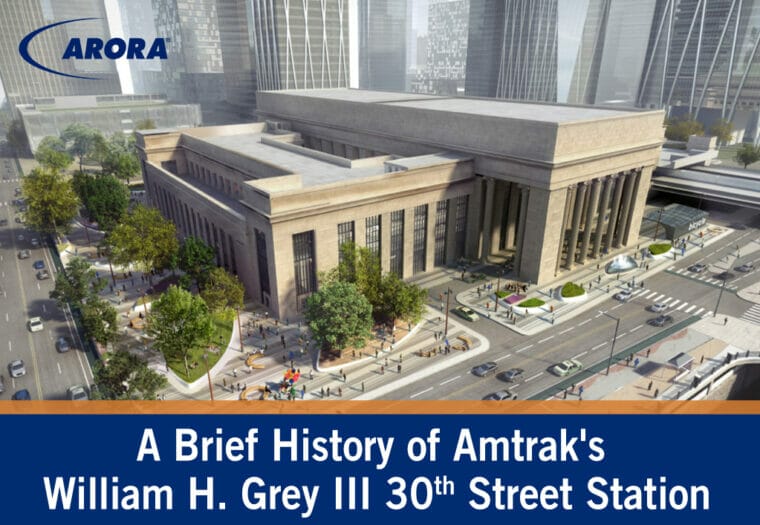News | Sep 20, 2022 | Christyn Binder
A Brief History of Amtrak’s William H. Grey III 30th Street Station
Philadelphia’s own William H. Grey III 30th Street Station, built in the early 20th century to replace Broad Street Station, was recently deemed one of Architectural Digest’s 37 most beautiful train stations in the world. 30th Street Station, replete with elegant Neoclassical details, is one of the most architecturally opulent structures in the entire city.
Even 30th Street’s predecessor, Broad Street Station, was a beautiful, towering Victorian-esque structure typical of local Philly architect, Frank Furness, who adorned the massive center city station with Gothic spires and arched windows . Broad Street station’s major downfall was its stub-end terminal design which forced trains to back in and out, creating upwards of 45 minutes of added travel on various lines.
In 1927, after outgrowing Broad Street, the Pennsylvania Railroad (PRR) began construction on 30th Street – a massive neoclassical station which could not only capitalize on the recent electrification of Amtrak’s northern corridor, but accommodate trains directly between New York City and Washington, D.C. (a route previously impossible via Broad Street station).
The eight-story steel frame structure features massive 70ft Corinthian columns supporting porticos sprouting east and west from the Alabama limestone-clad façade. The station is perched upon an elevated deck, allowing rail lines and the Schuylkill Expressway to pass underneath. Massive caissons 80ft below grade carry the load of the column foundations, and, in order to prevent track and road vibrations from disturbing station inhabitants, the footings of the track slabs and roads were designed to be tectonically independent of the structure supporting the station.
The interior was flanked with ornamental columns and soaring 95ft coffered ceilings, stories-high cathedral windows, art deco chandeliers, and gleaming Tennessee marble floors, with many of these grand architectural features still adorning 30th Street to this day. Though, the station and its surroundings have undergone several renovations since its Depression-era debut. This included a $75 M development effort to restore the Main Concourse from 1988-1991, and the construction of a $180 M, 29-story office building, Cira Center, in 2005 which was erected in place of a former parking deck that sat over rail tracks across Arch Street from 30th Street.
Arora Engineers (Arora) is honored to provide multidisciplinary engineering design services for the Station’s latest development – a 500,000 SF, multi-million-dollar renovation and modernization project led by Plenary Infrastructure Philadelphia. We have compiled interesting facts about our very own William H. Grey III 30th Street Station:
1. The station was listed on the National Register of Historic Places in 1978. The edifice’s nomination form summarized the station’s significance to the city and the nation as follows: “The 30th Street Station has endured as one of the last examples of the architecture of the past great railroad era. It is a building of self-evident importance and a significant landmark for the City of Philadelphia.”
2. 30th Street is rare in that it is one of the few stations in the country where trains arrive and depart from all four directions: from Boston in the north to Florida in the south, and from Atlantic City in the east to Chicago in the west. This advantageous position has contributed to 30th Street’s ranking as Amtrak’s third busiest station.
3. The nostalgic split-flip solari arrivals and departures board at William H. Gray III 30th Street Station, which was Amtrak’s last in service, flapped for the last time on January 16th, 2019. The board is currently displayed on an interim basis at the Railroad Museum of Pennsylvania while plans are evaluated as to whether the board can be incorporated into the current redevelopment project.
Other pioneering technologies the station featured when it opened in 1933 included an elaborate buzzer and intercom system and an integrated pneumatic tube network for internal communications.
4. The massive transportation hub also incorporated unusual fixtures such as a chapel, later used as a mortuary, and 3,300 SF of hospital space. The chapel, once a non-denominational worship space, was repurposed to serve as a morgue during WWII when railroad travel peaked. Today, the space serves as a conference room, which SEPTA employees refer to by its former name, the chapel.
5. President Barack Obama signed bill P.L. 113-158 into law in August of 2014 to officially rename 30th Street Station as the “William H. Gray III 30th Street Station.” The bill honored late U.S. Representative William H. Gray who served Pennsylvania’s 2nd District from 1979 -1991.
Gray, the first Black member of Congress to chair the critical Budget Committee, was lauded by his colleagues for his ability to broker bipartisan compromise and pass Democratic budget resolutions with a focus on social spending. Grey stated, “I seek [a budget] that doesn’t sacrifice programs for the poor and minorities, one that is fair and equitable.”
The bill to rename the Station to its current designation, William H. Gray III 30th Street Station, came from Chaka Fattah, who at the time held Grey’s congressional seat. Fattah lauded Gray, as Chairman of the House Budget Committee, for leading the fight against proposed cuts to eliminate Amtrak in 1985, and later, securing millions to renovate 30th Street Station.
To learn more about Arora’s scope of work on the Amtrak William H. Gray III 30th Street Station Redevelopment project, click here.



